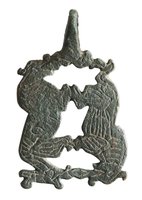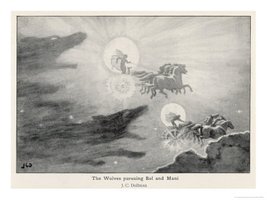Sköll had our sun grabbed last Friday, but the sun had escaped the attack - a horse harness pendant depicting their story..
This week's blog is from myself. Next week's blog.. is a surprise.. a Russian surprise in fact.
But first.. the intruiging story of Sköll and Hati, captured in an intruiging and utmost (unique) rare artefact..
This week I'd like to show you a probably unique cast bronze Viking harness pendant of 11th century date, formed as two wolves chasing each other; probably representing the celestial wolves Sköll and Hati wo chase sun and moon.
It was found at Thetford in Norfolk.
Looking at it as a 'Yin & Yang' kind of symbolic way, the two wolves represent 'good' and 'bad'. Black and white. Sometimes the light is in our lives, sometimes the dark part takes over.. They are chasing one another in an everlasting 'circle of life'.
The legend of Sköll and Hati
In Norse mythology there is the intruiging legend of Sköll and Hati, wich goes as following:
"Long, long ago, at the beginning of time. The god Odin, the all-father put the sun and moon into magical chariots to fly across the sky. The god told sun and moon to take their chariots and travel across the sky once a day, but that wasn't how it worked out.
Sun liked watching waves crash on the shore, so he would hold the sun for hours close to the earth. All of that heat turned the land into a desert, and left the rest of the world dark and cold. Moon liked the sight of the deep forests, where she would tie her horses for hours on end. What's more, the animals and people, even the gods didn't know when to wake and when to sleep.
The gods in Asgard sent messengers to Sun and Moon, they offered them gifts of gold and jewels, but the children just laughed.
"We shine more brightly than gold or jewels," said Sun.
Odin even threatened them with his magic spear, but Sun and Moon knew that the gods needed them to travel across the sky. Now that they had the job, they were going to do it just the way that they wanted. Besides, if the gods attacked their chariots, they may destroy the sun and moon forever.
Loki, the Trickster..
Loki, the god of mischief smiled as he watched Odin and the other gods rage over the work of Sun and Moon. But his smile turned to a frown when he realized where the Sun had stopped his chariot. It was right above the volcano home of Surt, the fire giant. Loki had long been plotting to sneak into Surt's mountain and steal the fire diamond, a huge and beautiful gem made of living fire. Now, with the sun always shining, the giants that guarded the mountain were always awake, and Loki couldn't sneak past them.
Loki was thinking about his problems as he walked through a forest. He was far from the Sun and the trees stretched long shadows across the ground. Loki heard a growling sound. He quickly climbed into a tree and saw a pair of wolves chasing an exhausted deer through the forest. That gave Loki an idea.
Loki knew that no ordinary wolves would do for his plan, so he traveled to the Ironwood, a land of giants and trees as strong as steel. There he found two giant wolves, Skoll and Hati.
Loki went to the forest and shot a deer with his bow. He roasted its meat with garlic and onions, and brought it to the wolves' cave.
"I have a gift for you," said Loki, giving them the meat.
The creatures gobbled the meat down in a single bite. They had never tasted cooked meat and spices before.
"More! We want more! Get us more," they growled.
"I can't help you with that, but I can tell you where to find some more meat like this," said Loki.
Loki took the wolves outside and pointed to the Sun and the Moon, sitting motionless in the sky.
"That is where you will find more meat like that," said Loki.
"Grrr what good does that do us? We can't fly," said Skoll.
Flying powder..
"Now I can help you there," said Loki, and saying that, he took out the pouch of flying powder that he had stolen from Odin and sprinkled it on each of the wolves.
The giant wolves leapt into the sky.
"Grrr, I want the Sun," growled Skoll.
"Fine, but I get the Moon," said Hati.
And the wolves were off.
When sun and moon saw the wolves, they drove their chariots high into the sky.
From that day on, the sun crosses the sky to make day, and the moon crosses the sky to make night, and all parts of the world get at least some light and some darkness, so animals, people and gods all know when to sleep.
But you may have noticed that at some times of the year, the Sun moves more quickly over the sky and at other times, it moves more slowly. That is because during the summer time, when the south wind blows, Skoll gets tired, and his fur feels warm, so he slows down. But When the north wind blows, and cold winds waft over the world and sky, Skoll feels stronger and chases the sun even faster than before, making out winter days much shorter than our summer days".
It was no sun eclipse..
So.. last weeks Friday - Sköll seemed to catched up with the sun.. but at the end of the morning, the sun escaped.. once again. For this time..
One day, he won't succeed in this, anymore...
Well. I could have been with these stones until after dark, but as my wife wanted to travel on.. well.. I see you again, some day, hogback stones from Gosforth. And if you happen to be there one day, do not forget that monument on the outside...
Further on with the Cumbrian hogbacktour !
In - yes, luckily again in - St. Peter's church in Heysham, there is a truly beautiful hogback stone. The guide told us, it had been studyied by Thor Ewing, a writer, in 2000. in 'Understanding the Heysham hogback' A tenth century sculpted stone monument and its context (link), Thor Ewing tells in detail what he dicovered on the both sides of this hogback stone.
Just being brought in the church as late as the 1970's accompanied with some protest here and there among the church visitors, considered as being a token of old paganism, it had been remarkably nice preserved, and a lot of detail can be seen, still. Truly worthwile a visit.
I had a small debate with the guide in the church if the - zoomorphic, in my opinion - faces on the sides were lions (or hippo's). The guide doubted if the vikings could have known about lions. Well I guess so, concerning the runes on the Ancient Greek lion statue at the Arsenal, Venice. For example. Vikings did travel south..
But when he told me he was doubting the vikings 'discovered' (as the native inhabitants were of course, in the first place) America before Columbus, I decided to rest my case..
One has to know when to start and to end a conversation ..
Just discovered the book in a bookstore written by Geoff Holder - The guide to the mysterious Lake District, I knew there had to be another hogback stone in Lowther, St. Micheal's Church. With a promising image described in the text of 'a naval and a land-based force of shield-bearing vikings above a fish and what might be a coiled sea serpent. On the reverse is a row of female figures with snakes, possibly a representation of the hideous hag Hel'. Wow. If that did not sound as a true pagan promised land ..
Not complaing too much after all we have seen, this visit was the dissapointing one of them all. But if you wife states 'I am happy to have seen them' and I am answering 'Measuring is knowing' and the even more obligate verb 'handling 'if we did not see it at all, we wouldn't have known anything at all of how they were looking' the glass was again half full, at the last day of our journey..
The hogback stone appeared to be just being tolerated within the entrance segment part of the church. As something you never use anymore but you do not throw away - entirely. That sort of feeling emerged when seeing this hogback asylum seekers.. Bed, bath and bread, ás we say in Dutch, but no luxury at all and standing on some outcuts of wood, you would balance the table with at home..
Come on, St. Micheal's Church.. care a bit more of your 'children' !
This hogback stone was moved in the church in 1907. Hogback stones layed partially buried in the churchyard before it was dug up and moved into the church.
The promising depiction of a longship - as certainly can be seen after some studying - see http://vikingminds.co.uk/pages/longship
we have missed !
The stone itself is (157 x 50 x 30 cm) and very worn.
The hogback stones in Cumbria - very diverse in quality, but everyone worth a visit ! Especially on a gloomy day in late October ...
The churches to visit - see photos of resp. St. Andrew's church in Penrith, St. Mary's church in Gosforth, St. Peter's church in Heysham and St. Micheal's church in Lowther.
Did I miss out on another one in Cumbria ? Let me know !
In a next blog I will take you to four - still remaining utterly mysterious- statues 'guarding' the graveyard of St. Andrew's church in Dacre..
For the last blog of October 9th see this link.
References: (as always, links to where the books can be ordered are attached).
Edwards, B.J.N. Vikings in North West England - The artifacts (1998);
Emery, Gordon, CURIOUS CUMBRIA, The Lake District & Beyond: A celebration of Cumbria (2023)
Ewing, T. 'Understanding the Heysham hogback' A tenth century sculpted stone monument and its context ;
Hall, R. Viking Age archaeology in Britain and Ireland (first printed 1990, reprinted with amendments in 1995);
Holder, G. The guide to the mysterious Lake District (2009)
possibly also (as there within the part of Cumbria dealing with Carlisle, the Eden Valley, Barrow-in-Furness, Whitehaven and the west coast is being dealed with)
Holder, G. Paranormal Cumbria (2010)
http://vikingminds.co.uk/pages/longship

